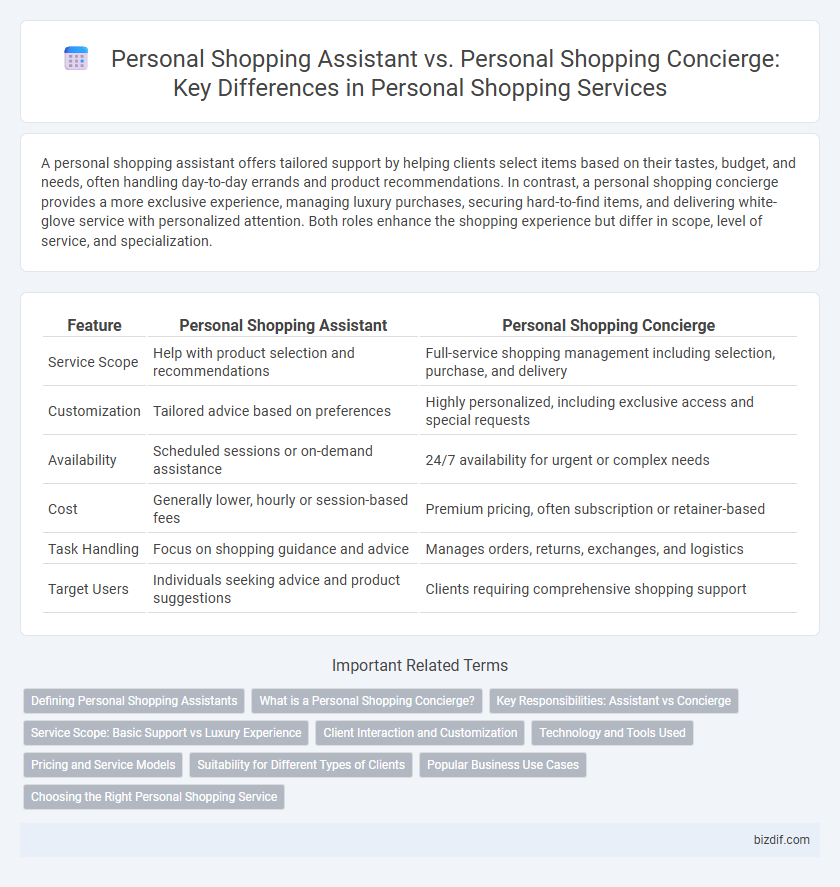A personal shopping assistant offers tailored support by helping clients select items based on their tastes, budget, and needs, often handling day-to-day errands and product recommendations. In contrast, a personal shopping concierge provides a more exclusive experience, managing luxury purchases, securing hard-to-find items, and delivering white-glove service with personalized attention. Both roles enhance the shopping experience but differ in scope, level of service, and specialization.
Table of Comparison
| Feature | Personal Shopping Assistant | Personal Shopping Concierge |
|---|---|---|
| Service Scope | Help with product selection and recommendations | Full-service shopping management including selection, purchase, and delivery |
| Customization | Tailored advice based on preferences | Highly personalized, including exclusive access and special requests |
| Availability | Scheduled sessions or on-demand assistance | 24/7 availability for urgent or complex needs |
| Cost | Generally lower, hourly or session-based fees | Premium pricing, often subscription or retainer-based |
| Task Handling | Focus on shopping guidance and advice | Manages orders, returns, exchanges, and logistics |
| Target Users | Individuals seeking advice and product suggestions | Clients requiring comprehensive shopping support |
Defining Personal Shopping Assistants
Personal shopping assistants provide tailored product recommendations and streamline purchasing by understanding individual preferences and budgets. They focus on simplifying the shopping experience through personalized advice and timely notifications about deals or new arrivals. Unlike personal shopping concierges, assistants typically operate through apps or online platforms, emphasizing technology-driven convenience over luxury service.
What is a Personal Shopping Concierge?
A Personal Shopping Concierge offers a tailored, high-touch service combining expert style advice with exclusive access to luxury brands and private sales. Unlike a Personal Shopping Assistant who primarily handles purchasing and logistical support, a concierge curates personalized shopping experiences, managing everything from wardrobe planning to event styling. This service prioritizes convenience, exclusivity, and individualized attention to elevate the shopper's lifestyle seamlessly.
Key Responsibilities: Assistant vs Concierge
A personal shopping assistant primarily handles tasks such as researching products, creating shopping lists, and managing orders to streamline the purchasing process. In contrast, a personal shopping concierge offers a more comprehensive service including personalized style advice, exclusive access to limited-edition items, and coordinating luxury shopping experiences. The assistant focuses on efficiency and organization, while the concierge emphasizes customization and high-end client service.
Service Scope: Basic Support vs Luxury Experience
A personal shopping assistant typically offers basic support such as product recommendations, price comparisons, and assistance with online ordering, catering to everyday shopping needs. In contrast, a personal shopping concierge provides a luxury experience that includes exclusive access to high-end brands, customized style consultations, and personalized purchasing tailored to individual tastes and occasions. The concierge service emphasizes convenience, exclusivity, and a high level of client engagement beyond standard shopping assistance.
Client Interaction and Customization
Personal shopping assistants provide tailored support by understanding client preferences and offering personalized product recommendations through direct interaction, ensuring an efficient and customized shopping experience. Personal shopping concierges elevate this service by delivering a more intimate and high-touch approach, managing every detail from exclusive access to hard-to-find items to personalized styling, resulting in a fully curated and client-specific experience. Both prioritize customization, but concierges emphasize a deeper level of client engagement and bespoke service.
Technology and Tools Used
Personal shopping assistants use AI-powered apps and data analytics platforms to curate personalized product recommendations, leveraging machine learning algorithms for enhanced customer preferences analysis. Personal shopping concierges incorporate advanced virtual reality tools and real-time inventory management systems, integrating seamless omni-channel experiences for clients. Both roles utilize mobile applications and CRM software, but concierges often employ more sophisticated automation and client engagement technologies to deliver bespoke services.
Pricing and Service Models
Personal shopping assistants often operate on an hourly rate or per-session fee, providing targeted style advice and personalized item selection based on client preferences. Personal shopping concierge services typically offer tiered membership plans or retainer fees, delivering comprehensive shopping experiences including wardrobe management, exclusive access to designer items, and tailored lifestyle shopping. Pricing for concierge services is generally higher due to the expanded scope and premium service model that emphasizes convenience and exclusivity.
Suitability for Different Types of Clients
Personal shopping assistants cater to clients who prefer hands-on guidance and personalized wardrobe updates, ideal for individuals seeking regular styling support or specific event preparation. Personal shopping concierges serve high-net-worth clients requiring exclusive access, luxury brand connections, and comprehensive lifestyle management for seamless shopping experiences. Both roles differ in client engagement intensity and service scope, tailor-fitting diverse needs from routine advice to elite luxury curation.
Popular Business Use Cases
Personal shopping assistants typically support retail environments by providing personalized product recommendations and streamlined purchasing experiences, enhancing customer satisfaction and boosting sales metrics. Personal shopping concierges cater to high-end clientele with tailored wardrobe planning, exclusive access to limited-edition items, and coordination of luxury shopping experiences, often utilized by fashion boutiques and luxury brands. Businesses leverage personal shopping assistants for e-commerce efficiency, while personal shopping concierges serve premium markets requiring bespoke services and high-touch client interactions.
Choosing the Right Personal Shopping Service
A personal shopping assistant offers tailored product recommendations and hands-on help with selecting items, while a personal shopping concierge provides a comprehensive, high-end experience including exclusive access, customized styling, and seamless logistics support. Choosing the right personal shopping service depends on your budget, desired level of personalization, and the complexity of your shopping needs. Understanding these distinctions ensures you receive expert assistance aligned with your lifestyle and preferences.
Personal shopping assistant vs Personal shopping concierge Infographic

 bizdif.com
bizdif.com